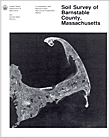The following is a map unit description from the "Soil Survey of Barnstable County, Massachusetts (Fletcher, 1993)"

PsB-Plymouth loamy coarse sand, 3 to 8 percent slopes, very stony. This very deep, gently sloping, excessively drained soil is on the crests and side slopes of hills in areas of glacial lake deposits, on ground moraines, and in areas of ice-contact deposits. Stones and boulders cover 1 to 3 percent of the surface. The soil makes up about 0.6 percent (1 442 acres) of the survey area. It is mapped mainly in the PlymouthCarver-Barnstable general soil map unit. Areas are irregular in shape and range from 5 to 150 acres in size.
Typically, the surface is covered with an organic layer. This layer is about 1 inch of loose, undecomposed pine needles, leaves, and twigs and 1 inch of partly decomposed and well decomposed organic material. The surface layer is about 3 inches thick. It is black, very friable loamy coarse sand in the upper 1 inch and gray, loose coarse sand in the lower 2 inches. The subsoil is about 26 inches thick. In sequence downward, it is 1 inch of dark brown, very friable gravelly loamy coarse sand; 5 inches of strong brown, very friable gravelly loamy coarse sand; 1 0 inches of yellowish brown, very friable gravelly loamy coarse sand; and 10 inches of light yellowish brown, loose gravelly coarse sand. The substratum extends to a depth of 65 inches or more. It is light brownish gray, loose gravelly coarse sand in the upper 12 inches and pale brown, loose coarse sand in the lower part.
Included with this soil in mapping are small areas of Barnstable, Carver, Hinckley, and Nantucket soils. Also included are areas where slopes are less than 3 percent or more than 8 percent and some areas where stones and boulders cover more than 3 percent of the surface. Included soils make up about 30 percent of this unit.
Permeability is rapid in the subsoil of the Plymouth soil and very rapid in the substratum. Available water capacity is low. Depth to the seasonal high water table is more than 6 feet.
Most areas are used as woodland. Some areas have been developed for homesites.
This soil is unsuitable as cropland because the surface stones and boulders restrict the use of equipment. Droughtiness also is a management concern.
This soil is suited to native pasture. It is poorly suited to hay and improved pasture because the use of equipment is limited by the surface stones and boulders. The main management objective is the prevention of overgrazing, which reduces the hardiness and density of desirable plants. Proper stocking rates, timely grazing, and restricted use during wet periods help to maintain plant density and minimize surface compaction.
This soil is suitable as a site for buildings with or without basements. The droughtiness is a limitation affecting lawns and shallow-rooted trees and shrubs. Adding a layer of topsoil and frequently watering during dry periods help to overcome this limitation. The soil readily absorbs but may not adequately filter the effluent in septic tank absorption fields. The poor filtering capacity may result in the pollution of ground water. The hazard of pollution increases with the density of housing. Precautionary measures may be necessary in some areas.